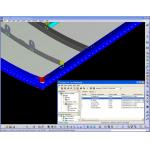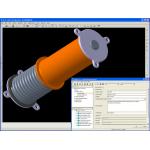Latest News
November 1, 2005
By Steven C. Luby
New tools link a wide-ranging variety of data directly to the 3D MCAD model.
PLM (product lifecycle management) is all about harnessing more data about the entire lifecycle of a product and enabling the reuse of the information to improve decision-making and efficiency.
If you are in a company that is implementing PLM, you know that the most vital phase of the process is during design, when product requirements, analyses, design, and process planning incubate, develop, and mature.
But for many of us the most difficult aspect of PLM is securing and structuring the design data in the first place. The geometry of the part is in MCAD, of course. But the non-geometric data, the information such as specifications, process descriptions, and so forth, has had no single repository. It is stored in Word and Excel files, on web pages on company intranets, and in countless notebooks and memos in disparate locations. Some of it is based on historical experience, and some of it is the result of recent innovations. This non-geometric information is vital for informed decision-making, and it is at its most useful when it is reviewed in the context of the MCAD model.
It’s too bad we can’t just glue a note onto a feature of the MCAD model to include detailed information inside the model.
Or perhaps we can. MCAD-integrated software tools are providing engineers with the “digital glue” to link the what of designs—specifications and other important non-geometric data—directly to the MCAD model. For instance, a manufacturer of customizable surveillance aircraft used our EnCapta software to create a catalog of fasteners in tables linked associatively to features of the MCAD model (see Figure 1, below). By clicking on a feature, designers can bring up tables of the various fasteners appropriate for use at that point on the airplane, including information about which fasteners were used for the various configurations.

› › Figure 1: Shown is an aircraft assembly within a CATIA V5 modeling session. The EnCapta window in the lower right corner lists the various fastener types and pertinent information about them, including clench length, quantity, and other part-specific data. Selecting one of the structural members highlights all the fasteners of that type in the model, shown in green.
As a result, designers no longer need to research fastener information in outside sources, such as supplier catalogs or spec sheets. Instead, all the information is available in a specialized design environment that reduces engineering time, promotes correct design decisions, and increases the accuracy of purchase quantities. More than half of the data entry for selecting and defining fasteners has been automated in this manner, reducing the potential for error and generating considerable time savings.
MCAD-integrated tools are also proving a boon to companies that need a convenient place to document the why — the rationale behind designs. For example, an aerospace company uses MCAD-integrated software to store legacy data with the MCAD model of a complex high-speed turbine for a rocket engine (see Figure 2, below). The information explains the reasoning behind three generations of design decisions — for example, establishing the clearance required between the casing wall and the turbine blades when the turbine is spinning.
‹ ‹
Figure 2:
Shown is a mechanical actuator within a Pro/Engineer Wildfire modeling session. The EnCapta form window in the lower right corner shows the revision history that documents why a change was made to the geometry. EnCapta highlights the pieces of geometry affected by this revision in orange on the MCAD model.
Having this type of information at hand shortens the design review process by more than an hour per drawing. Over thousands of drawings, that will greatly speed up the creation of future designs for turbines. In addition, the ease of learning and use of this type of software has overcome reluctance on the part of engineers to adopt yet another digital tool. It meets the important criteria of being part of the engineer’s familiar process, accessed from within software tools already used on a daily basis.
The benefits of using MCAD-integrated tools to structure and communicate design data are self-evident. You capture the data once, during the design process, and you then have it for the life of the product. Information is readily available up front in design, promoting better-informed decisions and reducing engineering time. And when the time comes to re-use a design, engineers have easy access to the reasoning that drove product development in the first place.
Today’s PDM and MCAD systems cannot do this. PDM systems lose the context of the data, the associativity between the non-geometric information and the geometry itself. And engineers cannot get detailed non-geometric information entered into a MCAD system out again, so that they can efficiently leverage it downstream.
The new design software also plays an important part in sharing product information across the enterprise. For example, XML technology can communicate data to applications throughout the enterprise, such as PDM and ERP systems, and to people in quality assurance or manufacturing.
In the long run, OEM-supplier relationships will also benefit from the new MCAD-integrated tools. Engineers will be able to transfer MCAD files back and forth with detailed product specifications and valuable design rationale information linked to the features of the model. The paper trail of e-mails, memos, and other documentation that presently moves along with drawings will be replaced by a single data repository — the 3D model — that contains the what and the why of a product.
Can PLM finally provide “a place for everything, and everything in its place”? Not quite. But MCAD-integrated software for capturing and leveraging data brings us one step closer to that goal.
Steven C. Luby is the President & CEO of VISTAGY, Inc. Send your thoughts about this article through e-mail by clicking here.
Product Information
EnCapta
VISTAGY, Inc.
Waltham, MA
CATIA V5
Dassault Systemes
Paris, France
Pro/Engineer Wildfire
PTC
Needham, MA
Subscribe to our FREE magazine, FREE email newsletters or both!
Latest News
About the Author
DE’s editors contribute news and new product announcements to Digital Engineering.
Press releases may be sent to them via [email protected].






